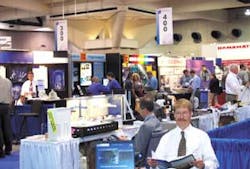As with Semicon West in mid-July, attendance at the annual meeting of the International Society for Optical Engineering (SPIE) in San Diego, CA, (which spanned a week, ending during the first few days of last month) settled down from the telecom surge of last year to a more typical size of about 5100 attendees, 2500 technical papers, and 243 exhibitors (see "Technology development efforts are still climbing"). Last year's SPIE annual meeting attendance had swollen by about 500 additional attendees, and short courses related to telecom applications were sold out. But despite the lower attendance this year, "traffic on the exhibit floor was not bad," according to Scott Walker, director of SPIE corporate services (see figure).
Walker attributed the resilience on the SPIE exhibit floor, during a time of widespread market woe, in large part to the annual meeting's focus on research and engineering topics in traditional optics applications. The effects of the market dip seems more isolated to telecom and semiconductor markets, he said, while scientific, engineering, and other customers are still buying. He also characterized the exhibit at the SPIE annual conference as one of the last remaining optics shows focusing on optics R&D as opposed to lasers, industrial optics, or even fiberoptics applications.
Special events among the 84 technical conferences included three sessions on optical science and metrology at the National Institute of Standards and Technology (Gaithersburg, MD) in recognition of the institute's 100th anniversary. Among numerous conferences on various aspects of remote sensing, general media attention was drawn to presentations from astrobiology researchers on the topic of extraterrestrial life forms. Researchers supporting the possibility of life on Mars presented evidence gathered from "ancient graphite in the Ukraine, Antarctic depths, extraterrestrial meteorites found on Earth, dust in the upper atmosphere, the Hubble Space Telescope and from Mars itself," according to Gilbert Levin, CEO of Spherix Inc. (Beltsville, MD). Levin asserted, "The researchers provided the strongest evidence to date for primitive life forms on Mars." Public viewing of imagery of the asteroid 433 Eros from the Near Earth Asteroid Rendezvous mission was also provided for the first time.
Touch-screen technology
More down-to-earth technical presentations included a description of the optical characteristics of mating a touch screen with a full-color, active-matrix, organic light-emitting-diode display. Pioneer (Tokyo, Japan), Sanyo (Osaka, Japan), and TDK (Tokyo, Japan) have taken the lead in efforts to commercialize OLED display screens, while Kodak (Rochester, NY), Pioneer, Sony (Tokyo, Japan), Philips (Eindhoven, The Netherlands), and others are developing improved OLED display materials and devices for the next generation of flat-panel displays, according to A. D. Cropper, who demonstrated display R&D efforts at Kodak with a colorful flat-panel presentation of the Disney movie "Fantasia." Cropper added that Clare Inc. (Beverly, MA) has developed a column driver integrated circuit for passive-matrix OLEDs that might be used in cellular phones, personal digital assistants, automobile navigation systems, and small television screens.
Engineers at Kodak and Sanyo have combined active-matrix, low-temperature-poly-silicon OLED with touch-screen devices, and then investigated the resulting optical properties for various display applications, Cropper said. The engineers found that mating with touch screens tended to decrease OLED display luminance in 2.4-in. devices between 16% and 29% (with increasing viewing angle to 70°) in the red, between 14% and 64% in the green, and between 15% and 41% in the blue. White-light luminance decreased between 36% and 39% depending on the type of finish (matte or antireflective coating, respectively) used in the touch screen.
There is substantial motivation in terms of potential market demand. Touch-screen vendors have projected annual revenue to approach $2 billion by 2004, according to Cropper. "As the number of products with displays increases, the opportunity for touch-screen interfaces increases."
About the Author
Hassaun A. Jones-Bey
Senior Editor and Freelance Writer
Hassaun A. Jones-Bey was a senior editor and then freelance writer for Laser Focus World.
